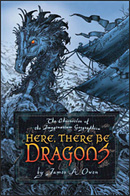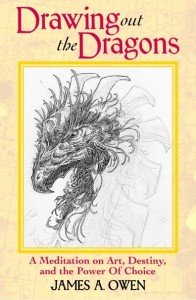Guest Post by Dan Wells
Congratulations! You finished NaNoWriMo this year–a 50,000-word novel in just one month. Maybe it’s a full story, or maybe it’s just a beginning; maybe you printed out the little diploma and hung it on your wall, or maybe you didn’t even finish. Maybe you didn’t even do NaNoWriMo this year, but you have a book left over from last year, or a book that you wrote without any connection to NaNoWriMo at all. The point is, you wrote a book. Hooray! That’s a step most people never even make it to, and you’ve done it. Good for you.
Now it’s time to go back and make it better.
“Revision” is, for a lot of writers, a scary word. You may think I’m trying to give you a bunch of extra work. You may think I’m telling you that the book you wrote doesn’t count, and that you have to write the whole thing again. You may even think that the book you wrote is brilliant and doesn’t need to be revised at all. Rest assured that your book IS brilliant, and it DOES count, but that you need to revise it anyway. Revision is something that a lot of aspiring writers balk at, but experienced, professional writers never question. It is our very best friend, and, quite frankly, one of the primary reasons we are professional writers. Revision is a magical process that will turn your finished book into an excellent book; it will take your brilliant story and refine it in a way that will help everyone recognize its brilliance. Think of the recipe for your favorite food: even if you have all the right ingredients, the dish won’t turn out like you want it unless you combine them in exactly the right way–and even if the flavor is perfect, the best chefs will spend just as much time on presentation and serving, making sure that every aspect of the meal is perfect.
Or, to make things easier, I can sum up that entire paragraph in one sentence: your first draft is for what you want to say, and your final draft is for how you want to say it.
The revision process starts with distance. Remove yourself from your writing for a while–a few days, a few weeks, a few months, whatever it takes to give yourself a fresh perspective when you come back to it later. Work on other projects, read other books, and cleanse your mental palate. If you have someone willing to read your work, give them the manuscript so you can get some outside feedback. The purpose of this step is to help yourself see the book for what it is, not for what you think it is. Inside your mind you have an idealized view of the story you wanted to tell–you know what emotions you wanted to create, what reactions you wanted to elicit in the reader, and which parts of the story would be exciting or romantic or scary or sad. While you were writing it, you saw it the way you wanted it to be. Other people–and yourself, with enough distance–don’t have that idealized view, and they’ll see your story for what it really is. When you give yourself distance and come back with fresh eyes, you can compare the story on the page to the story in your head and figure out which parts worked and which parts missed the mark. WARNING: most of it missed the mark. I can tell you that without even reading it, because that happens every time, and it happens with every author. The more you write, and the more you develop your skills, the better your first drafts will be, but even your very favorite writers write bad first drafts. They do it all the time. I do it myself. The trick is to not let it get you down–don’t get depressed, don’t give up, just use this as an opportunity to fix what’s wrong. Again, think of a chef: when she tastes her latest creation and realizes there’s not enough salt, she doesn’t close her restaurant and move away and never cook again, she adds more salt. You’re not here to agonize over your problems, you’re here to solve them.
Step two, of course, is to look really closely at the problems you found in step one, and figuring out exactly what’s causing them. To continue the metaphor, step one is where you taste the food and realize something’s wrong; step two is where you figure out that it’s wrong because it doesn’t have enough salt. Like all things, this comes with practice, but you can start that practice by asking the right questions. It’s not enough to say “this book is bad,” you have to ask yourself why it’s bad. Is it boring? Are the characters unlikable? Is it hard to understand? Maybe your helpful friend who read the book told you he couldn’t figure out why the characters were doing what they were doing. Your job, as the author, is to look at those characters and their actions with a discerning eye: do they have good reasons for what they’re doing? Do those reasons connect as logically to their actions as you thought they did when you wrote it? Are those reasons clear in your mind but never really presented well on the page? Say the book is boring: does the reader have good reasons to care about what’s happening? Does the reader like the characters enough to be invested in their problems? Does the reader have all the information they need to be ready for the climaxes and the cliffhangers and the big emotional payoffs? No matter what the larger problems might be, you can dig underneath and find the specific issues that are causing them.
Once you’ve identified specific issues, step three is to figure out how to solve them. Let’s look at character motivations again: your readers (and perhaps even yourself, if you’ve created enough distance from the manuscript) are confused about why the main character is doing what he’s doing, and you’ve determined that this is because his motivations are never properly explained. There are many, many, many ways to solve this, and you need to figure out which is the right one. Do you just add a few lines of inner monologue where he explains himself? Maybe several lines, scattered throughout the book, where he reaffirms his personal beliefs? Maybe you need a new scene–the bad guys do something that affects the main character personally, so he has a clear and visible reason for opposing them. Maybe you need to add a new character: a dependent who the bad guys can hurt, or a buddy that the main character can talk to, or a romantic interest that will give the main character something to fight for. Maybe your character’s motivations rely on some key piece of knowledge she didn’t have access to in the first draft: oops! Figure out how to give her that knowledge, maybe with a mentor/traveler/newscaster/whatever who can explain it to her, or a scene of investigation or accidental discovery where she can learn it for herself.
It all boils down to this: when you look at your book critically and identify its weaknesses, you can drill deep down into what’s causing those weaknesses and figure out exactly how to make your book better. Once you’ve cleaned up the storytelling, you can do the same thing with the writing: polishing it and refining it until it’s not just good, but great. Learn how to revise, and your writing will become better than you ever imagined.
Dan Wells has a new book coming out in March called FRAGMENTS, the sequel to PARTIALS; it’s a post-apocalypse SF story about a group of plague survivors trying to rebuild civilization. Also check out his e-novella called ISOLATION that’s kind of sort of a prequel to the series and takes place several years before the apocalypse.
Bio: Dan Wells lives in Germany with his wife and five kids. Why Germany? Why not? He writes a lot of stories, reads a lot of books, plays a lot of boardgames, and eats a lot of food, which is pretty much the ideal life he imagined for himself as a child.



 A guest post by James A. Owen
A guest post by James A. Owen
